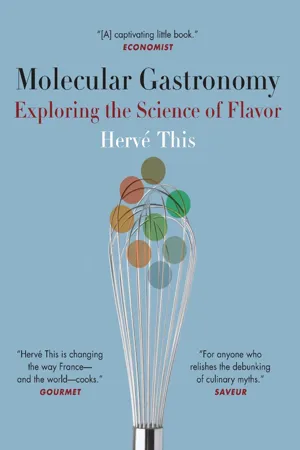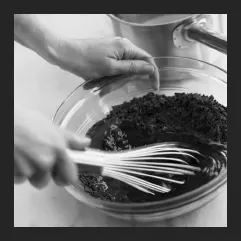![]()
![]()
1
Making Stock
Meat loses its juices no less readily when it is placed first in boiling water than in cold water.
BEEF STOCK (ALSO CALLED BROTH OR BOUILLON), chef Jules Gouffé wrote in Le livre de cuisine (1867), is “the soul of ordinary cooking.” Rather than water, which has no taste, cooks have long used wine or the liquid obtained by simmering meats and vegetables in water. This liquid traditionally is served as a first course, but it is used also to moisten various dishes and as an element in the preparation of sauces. How should it be made?
Cookbooks are filled with admonitions. “The gradual heating of the liquid,” states Le livre de cuisine de Mme. E. Saint-Ange (1927), “is of the highest importance for the clarity as well as for the flavorfulness of the broth.” The idea that meat ought to be cooked in water that is initially cold was advanced almost a century earlier by Marie-Antoine Carême, perhaps the most famous of all French cooks, also known as the “cook of emperors” for his service in Russia to the Tsar and in England to the Prince of Wales. Carême proposed an explanation in L’Art de la cuisine française au XIXe siècle (1833): “The broth must come to a boil very slowly, otherwise the albumin coagulates, hardens; the water, not having had the necessary time to penetrate the meat, prevents the gelatinous part of the osmazome from detaching itself from it.”
Some ten years before Carême, Brillat-Savarin wrote that “to have a good broth, it is necessary that the water heat slowly, in order that the albumin does not coagulate inside [the meat] before being extracted; and it is necessary that the boiling be scarcely perceptible, so that the various parts that are successively dissolved are able to blend intimately and readily.” The release of the meat’s juices is related, then, to the clarity of the broth.
Are we justified in supposing that the meat yields different quantities of juice depending on whether it is initially placed in hot water or cold water? Plainly everything depends on the length of cooking. Gouffé argued that the cooking must last several hours: “There comes a moment when the meat is cooked and has nothing more to give you in the way of juice or aroma. To let it remain in the pot after it has been completely exhausted by cooking, far from improving the broth, risks spoiling it. I advise a limit of five hours for a large pot-au-feu.”
It is hard to understand why, after five hours of cooking, the smell and taste should still depend on the temperature of the water at the outset. On the other hand, it is easy to see that the mechanical agitation of the broth places in suspension particles that have been separated from the meat, leading to a cloudy broth that will then have to be clarified, at the risk of weakening its flavor.
Since 1995 my colleagues and I have been comparing various cooking methods for broths. It soon became apparent that broths begun with boiling water were cloudier. Nonetheless, the problem of the initial temperature of the water persisted, despite the work of Justus von Liebig (1803–1873), universally known for his pioneering studies in organic chemistry and for his broths and meat extracts.
Liebig claimed that the essential nutrients of meat are found not in its muscle fibers but in its fluids, which are lost during roasting and broth making. When the meat is plunged into boiling water and the temperature then reduced to a simmer, Liebig wrote in an article published in 1848, “the albumin immediately coagulates from the surface [of the meat] inwards, and in this state forms a crust or shell, which no longer permits the external water to penetrate into the interior of the mass of flesh. But the temperature is gradually transmitted to the interior, and there effects the conversion of the raw flesh into the state of boiled or roasted meat. The flesh retains its juiciness, and is quite as agreeable to the taste as it can be made by roasting; for the chief part of the sapid constituents of the mass is retained, under these circumstances, in the flesh.” Conversely, in order to produce a good broth, he recommended against putting the meat in hot water because otherwise the juices would be confined in the meat and one would end up with a tasteless broth.
These precepts formed the basis for a commercial enterprise. Using a vacuum to evaporate the broth produced by cooking minced meat in cold water, Liebig obtained a “beef extract” that he sold throughout the world, simultaneously propagating the theory that broth is best made starting from cold water. Liebig was a good chemist, but on this subject he did no more than copy the writings of Brillat-Savarin, who was neither a scientist nor a cook, a half-century earlier. There is no question that plunging meat into boiling water blanches it immediately. But is this method less effective in extracting the juices?
Lost Juices
Nothing beats an experiment: Let’s cut up a big piece of meat into two equal parts and place half of it in cold water and the other half in boiling water; then let’s heat and periodically weigh the two pieces. We will find that the mass is very rapidly reduced in the boiling water and more slowly in the cold water.
After about an hour of cooking, however, the two pieces have lost the same amount (give or take a gram). After this point the mass no longer varies, even with several additional hours of cooking. Moreover, in a blind tasting the two broths are indistinguishable: Liebig’s broth theory, doubtful in principle, turns out to be false in practice.
However, our experiment suggests a new way of treating the boiled meat once its juices have been released. If it is left to cool sufficiently in the broth, its mass can increase by more than 10% because the meat absorbs the liquid. Why not let the meat cool in a juice made from truffles, for example?
![]()
2
Clarifying Stock
Does convection suffice to clarify a broth?
COOKBOOKS MAKE MANY CURIOUS CLAIMS. One by the late Bernard Loiseau asserts that adding ice cubes to a cloudy broth “stuns” the suspended particles, causing them to fall to the floor of the stock pot. One may quibble with this way of stating the matter, but does it contain an element of truth?
The Modeling of Broth
Let’s begin by selecting particles close in size to those that actually cloud beef broth. Ground coffee is a good candidate because it consists of particles of various sizes. But because, unadulterated, it would excessively tinge the color of the broth, let’s dilute it by running water through the grounds until the coloring agents are rinsed out. The result is a black powder of mixed granularity.
Let’s now divide this powder into two equal parts and put them in identical glasses containing the same quantity of water. After we heat the contents of the two glasses in a microwave oven, the particles suspended in both liquids reveal the presence of energetic currents that cease after a few seconds. Now, very carefully, put ice cubes in one glass and in the other a mass of hot water equal to that of the ice cubes. Nothing happens in the latter case, but in the glass with the ice cubes the suspended powder shows signs of intense agitation.
The observed motion is not surprising: The ice cubes cool the water in the upper part of the glass while melting and releasing cold—that is, dense—water. This dense water falls, and the hot water at the bottom rises and cools on contact with the ice cubes, which are warmed in turn, and so on until the ice cubes have melted.
What happens to the particles? Have they all been “floored” by a knockout blow from the cold water? Not really. A strange segregation appears: Although both the large and small particles in suspension are carried downward by the convective current and seem to be deposited at the bottom of the glass, in reality the upward current carries the smallest particles back with it. Why don’t the large particles rise again as well? Probably because particles that fall in a fluid have a maximum speed.
If the liquid were immobile, the particles would be subject to two forces: the weight of the particles themselves, pulling them toward the bottom, and the upward thrust—or buoyancy—described by Archimedes’ principle (equal to the weight of the fluid displaced by the particles). Ultimately the particles wind up forming a deposit because they are denser than the water and because the resultant of these forces pushes them toward the bottom.
Yet the falling particles are subject to another force that slows them down. The intensity of this drag depends on the viscosity of the liquid and the radius and velocity of the particles. To simplify matters, let’s begin by considering this force in isolation, acting independently of the others. During free fall, the force is initially zero (because the rate of fall is zero), and the particles are accelerated by the downward force. Gradually, however, the upward drag asserts itself, offsetting the resultant of the weight and the Archimedean thrust so that the particles end up falling at a constant speed, which is their maximum velocity.
The Segregation of Particles
When the liquid rises, after having fallen to the bottom of the glass, it tends to carry both the small and the large particles with it. However, these particles have different maximum rates of fall and therefore react differently. Because their radius is small, the small particles fall to the bottom at a speed that is less than that of the fluid’s upward motion. By contrast, the large particles, with their greater maximum speed, fall too fast for the ascending fluid to be able to carry them back up again; they remain at the bottom of the glass.
How can we test this hypothesis? Would it be possible to reproduce the experiment in a more viscous fluid and in this way modify the maximum velocity of the particles? Marc Fermigier of the École Supérieure de Physique et de Chimie in Paris, citing Darcy’s law for flow through porous media, observes that the increase in viscosity may slow the speed of convection and thus alter the phenomena being studied: In pure water the current pushes the particles back up along the curve of its path, below the convection cell, because it is able to penetrate the granular medium of these particles; the more viscous the fluid, however, the harder it is for the current to pass between them.
Fermigier’s colleague Eduardo Weisfred adds that the large particles, being more inert than the small ones, tend to shift to another line of current below the convection cell, so that they are carried toward areas where the current is less swift and where sedimentation is possible; the small particles, on the other hand, follow the fluid throughout its complete motion.
What is the practical lesson of all this? That only the large particles form a significant deposit, and the small ones will continue to cloud the bouillon—just as the lamb, the innocent polluter in La Fontaine’s fable, is said to have fouled the wolf’s drinking water.
![]()
3
Hard-Boiled Eggs
How to center a yolk and get the cooking time just right.
COOKBOOKS SAY THAT TO OBTAIN a hard-boiled egg with a centered yolk, the egg must be cooked in water that has already been brought to a boil. Experience often demonstrates the soundness of this advice, but sometimes one follows it and the yolk ends up being off center. Other times the yolk comes out in the center when the egg has initially been placed in cold water. What good is advice if it isn’t always good?
First things first. Why is the yolk sometimes decentered? Because it has changed position inside the egg. Why has it changed position? Because it is subject to the forces of gravity and buoyancy. Do these forces push the yolk upward or downward? It is often supposed that the yolk is more dense than the egg white. Let’s find out whether this is true by doing an experiment. In a tall, slender glass—a transparent “shell” that will permit us to see the respective positions of the yolk and the white—place a yolk and, on top of this, four or five whites. The yolk slowly rises, which is easily enough explained by the fact that it contains lipids, or fats, which are less dense than the water that makes up most of the egg white.
Does the fact that the yolk comes to float atop the whites account for its decentering in the hard-boiled egg? We can test this hypothesis by another experiment. First, place an egg on its side in a saucepan filled with water. Then bring the water to a boil and let the egg cook for ten minutes or so, making sure that it remains motionless throughout. On peeling off the shell of the hard-boiled egg we find that the yolk has moved toward the top. Let’s repeat the experiment with an egg that has been left in a vertical position long enough for the yolk to rise. If we cook the egg in the same position we discover that the yolk is decentered once again toward the top. These experiments confirm that the difference in density between the yolk and the white is responsible for the position observed.
“Yes, but what about the membranes that center the yellow in the egg?” those who know of their existence will ask. The experiment with the glass removes these membranes and so eliminates their effect, it is true. But the cooking experiment demonstrates that they are not sufficient to hold the yolk in place.
How, then, can we reliably obtain a cooked egg with the yolk in the center? The answer may be deduced from the preceding experiments: We must prevent the yolk from rising in the shell. How? By closing off the vertical axis of movement, and with it the yolk’s ability to float. In practice this means manipulating the egg while it cooks. Put one in boiling water, rolling it around in the saucepan for about ten minutes, and then remove the shell. You will find that the yolk is centered.
The same experiment, only starting with cold water, produces a centered yolk as long as one rolls the egg around for a longer time, which becomes tedious after a while. The cookbooks are partially correct, then, but they offer no insight into the forces actually at work. The key to success, it turns out, lies in not allowing the yolk to stay still.
Hamine Eggs
What is the recipe for a perfectly cooked egg? The question may seem odd because tastes vary so greatly. Some people like the dark green ring on the surface of the yolk, for example, and others detest the sulfurous odor that accompanies it. Cookbooks say to cook the egg for only ten minutes in boiling water, without any further explanation. Let’s look first at the problem of cooking time.
Why ten minutes rather than, say, five or fifteen? Because after five minutes the egg has not yet hardened, and after fifteen minutes it is assumed that the egg white will be rubbery and the yolk sandy. Yet the latter result is not universally observed throughout the world. Hamine eggs prepared in Jewish communities in Greece and elsewhere are famous for their tenderness, although they are cooked for several hours. How d...


